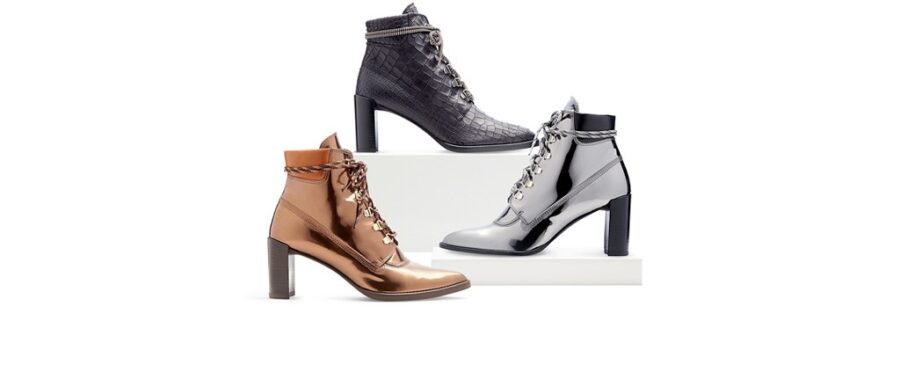The Stuart Weitzman shoe brand is associated with some of today’s most famous pop stars, actresses, and celebrities, including Taylor Swift, Beyoncé, Kate Middleton, Gisele Bundchen, Kate Moss and Gigi Hadid. Its stores are located on the most fashionable shopping streets in the world including Rodeo Drive, Via Sant’Andrea, Via Condotti, Michigan Avenue, Faubourg Saint Honore, and Madison Avenue. And millions of women in dozens of countries buy Stuart Weitzman shoes in retail stores and online.
How did the entrepreneur and designer of the same name build this globally-renowned business? Stuart Weitzman shared tales of his success at a recent Wharton Leadership Lecture. Weitzman also appeared on Wharton’s Marketing Matters radio show, which airs on SiriusXM channel 111. (Listen to the full podcast using the player above.)
Weitzman got into the shoe industry at a young age, working at his father’s Massachusetts shoe factory while still in college at Wharton. Later, he ran the family business with his brother. In 1986 he struck out on his own, launching his company under the Stuart Weitzman brand. In 2015, handbag maker Coach acquired the business for $574 million but kept Weitzman on as creative director, according to Forbes. Weitzman continued in that role until his retirement earlier this year.
Weitzman talked about the DNA of his brand. Sexiness is a key element, he said. “There’s an expression that ‘sex sells,’” he said. “If you can incorporate something sexy about a fashion product… you’ll get more business out of it.” That’s been proven from the fashion industry to the automobile industry, he added.
This idea was certainly reflected in his controversial ad campaign last year, which featured three supermodels in a tight embrace, all completely nude except for the brand’s sandals. (Weitzman said — perhaps tongue-in-cheek — that the ads had to be taken down from his New York storefronts because they were causing car accidents.)
“If you can incorporate something sexy about a fashion product … you’ll get more business out of it.”
But sexy isn’t everything: “stylish comfort” is important, too. He calculated that it costs him $8,000 to get a new customer into his store, based on the total investment in advertising, PR and editorial placement. If she leaves empty-handed, he’s lost that $8,000. “There’s no logic in getting you through [my] door, putting a shoe on you that’s going to kill you, and you’re not coming back.” Any new design that wasn’t a hit with his shoe tester was always taken out of the line.
The Million Dollar Sandal
Weitzman told the story of what he called the company’s “tipping point,” quoting the book by the same name by Malcolm Gladwell that analyzes how certain trends become enormously popular. Early in his business, Weitzman was trying to figure out how to offer his products to “a billion people around the world” and said that there wasn’t enough money “on the planet” to get his message out to all of them.
“I needed the help of something else, someone else, without them even realizing it because I certainly couldn’t pay for it,” he said.
That “something” was a breathtaking, one-of-a kind pair of sandals created by Weitzman in collaboration with a diamond company, each sandal encrusted with 464 diamonds with an 18-carat diamond hanging in the center. The “someone” turned out to be actress Laura Harring, co-star of the David Lynch movie Mulholland Drive, who agreed to wear them to the 2002 Academy Awards. She even pinned up her floor-length Giorgio Armani gown so the sandals would be more visible.
As Weitzman tells it, his bet paid off. Harring stepped onto the red carpet and the late comedienne Joan Rivers commented on camera, “Laura, come over here. Everyone wants to see Stuart Weitzman’s million-dollar sandal.” Weitzman said there were 400 million viewers for the Academy Awards that night, and the next week, a picture of Harring showing off the sandals appeared in more than 500 news outlets worldwide. The shoe got nicknamed the “Million Dollar Sandal.”
Weitzman calculated that it cost him $8,000 to get a new customer into his store, based on the total investment in advertising, PR, and editorial placement.
“[Now] everyone knew who we were,” said Weitzman. “They didn’t yet know all our products … but there was now a positive association with our brand.” Of this stunt that launched his company into public view, he said that luck may have played a role but he personally believes “you have to be good to be lucky.”
Taylor Swift’s Boot
Weitzman continued over the years to place his products in the hands (and on the feet) of celebrities to get more exposure for the brand. For example, he cultivated an acquaintance with Jennifer Anniston at the height of her career, and Anniston began wearing the brand’s new high-wedge espadrille around town. “She fell in love with it … she kept wearing and wearing it, and it had so much impact.” It was the first espadrille to be designed with an elevated heel and it became one of the company’s top-selling products, he said.
He talked about the subtleties of working successfully with the rich and famous. Making sure that items are quickly and easily available is key. “These people need things at the last minute. They don’t know where they’re going tomorrow; they don’t know what outfit they’re wearing…. You need to be able to play their game or you’re not going to be on the field with them.” He noted that the business keeps inventory of its most important items, in all sizes, to ship to celebrities at a moment’s notice.
A big celebrity promotional opportunity opened up in 2015 when Taylor Swift was preparing for her “1989” tour. Weitzman said a stylist was aware that other performers such as Jennifer Lopez and Beyoncé were very pleased with the shoes he made them and had suggested to Swift’s stylist that she contact Weitzman for attention-getting footwear designs. One design needed to be a thigh-high boot that Swift wanted to attach to a garter belt for the performances.
The boot, said Weitzman, was “what we still call, in our slang from Brooklyn, New York, a ‘home run.’” He said that a million of Swift’s followers wanted to know where they could get “Taylor Swift’s boot.” A version of the boot was added to Weitzman’s commercially available collection. “Now when [fans] found out it was $900, that dropped down to about 25,000 [people],” said Weitzman, to audience laughter. “But think about the impact of someone like that.”
He added that it had been important to translate the custom-made boot into a saleable product that most customers could wear. For one thing, the original boot had run very high on the leg to accommodate the garter belt. “When we created this for the exact height that I thought every girl would want, the story is that it became our biggest boot.”
The Power of Store Design
Weitzman said he’s always looked to do things that are exclusive and unique with an eye toward getting low-cost publicity for his brand, such as his “Million Dollar Sandal” escapade. (Not to mention the custom-made “priceless” sandals the company created the following year, which were topped with Swarovski aurora borealis crystals from earrings owned by Marilyn Monroe.) Moreover, his approach has extended beyond the product to the look and design of his stores.
“I personally believe you have to be good to be lucky.”
When Weitzman was ready to launch his Madison Avenue store in New York, he was concerned about measuring up to the luminaries already there: Barney’s, Prada, Gucci and the like. His wife suggested putting artwork in the window. The idea inspired a display of “art shoes” created principally by professional artists as well as talented local art students, he said, with fanciful shapes like race cars, flower bouquets, Alice in Wonderland characters, and baskets of puppies.
Weitzman used this type of display for two years (“The students were thrilled to get their name on Madison Avenue and 58th Street, and the works by the professional artists gave the store windows a unique and special identity”). Shoppers kept coming in, and the business continued to flourish. Many of the company’s print advertisements also displayed unusual shoe-inspired images rather than products, which Weitzman said conveyed to potential customers “the whimsy and creativity of Stuart Weitzman and company.”
Sometimes the goal of being one-of-a-kind has required knocking on doors more than once. A few years ago Weitzman got the idea of having a famous architect create retail stores for him. He approached the late Zaha Hadid, a prominent Iraqi-British architect who had received distinguished awards for her work including the Pritzker and Stirling Prizes.
At first, she didn’t even want to answer his phone calls, said Weitzman, and had no interest in making a shoe store. But, he said, “After persistence, a no sometimes can become a maybe, and a maybe can become a yes.” The first Hadid-designed boutique was opened in Milan in 2013, and others followed in Hong Kong, Rome and New York. The dramatic, unusual spaces of course got plenty of attention. “Nobody else had used an architect of this type to build a store like this,” Weitzman said.
Reflecting on having chosen the path of entrepreneurship, Weitzman spoke enthusiastically. “When you’re in your own business — not everybody’s going to be — but boy, if you can, it’s a great thing to do.” He talked about the “passion” of building an entrepreneurial company and observed: “It creates a love for it, and it becomes a hobby more than a business. You don’t count the hours and you don’t count the time.”
Weitzman was asked how it felt to step away from designing shoes for the now Coach-owned business, especially since it would continue to bear his name. He responded, “I still have an attachment to [the company], but I really have no issue with what goes on from here being Coach’s legacy.”
He said that the last Stuart Weitzman collection he had designed was “great” and that “everybody loved it,” which was a source of deep satisfaction. He compared his exit to that of legendary Boston Red Sox player Ted Williams: “In his last at-bat, the last game of his career, he hit a triple, a double and a home run.”



